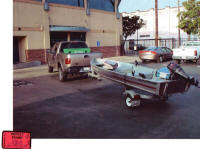
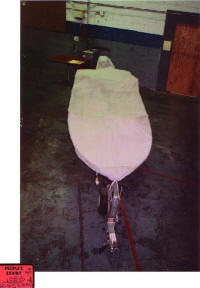
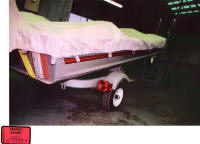
Sears Gamefisher Boat
1st search of the boat -- December 24, 2002
Boat seized and evidence collected -- December 27, 2002
Water sample taken -- December 30, 2002
Red paint transfer collected -- February 5, 2003
Motor tested, items collected -- February 14, 2003
Boat stability tests and measurements
Mark Geragos' boat demonstration and boat display
In his Closing Argument, Rick Distaso argued that in November Scott was thinking about murdering Laci, but something happened in December that "solidified it in his mind, and he had to do it." That was the phone call from Shawn Sibley on December 6 asking Scott if he was married. Then on December 9, he told Amber he had lost his wife. Distaso played short section of the taped phone call between Amber and Scott on January 12, 2003, in which Scott admitted that he knew Amber interpreted that to mean that his wife was "recently dead." Distaso then weaves in the boat purchase between the phone call with Shawn on the 6th and the discussion with Amber on the 9th to show that the boat was part of Scott's pre-meditated plan to murder Laci and dispose of her in the Bay.
The State argued that Scott kept the boat a secret, and the Defense was not able to produce anyone that knew about the boat or that could confirm positively that Laci knew about the boat. Laci's visit to the warehouse on the 20th and her request to use the bathroom of the neighboring business was discussed, but no proof was given that Laci saw the boat on the 20th.
Shortly after Thanksgiving, Bruce Peterson put an ad for the boat in the ModBee asking $1500. On Saturday, December 7, Scott browsed the online ModBee classifieds (People's 178). Scott called Bruce Peterson to inquire about his ad, and they setup a meeting for the next day, Sunday, December 8. They agreed on $1400, down from the $1500 asking price, but Bruce wanted cash. Scott said he would return after the bank opened the next morning, which he did, with $1400 in cash. He had withdrawn the money from the joint checking account. Scott gave his correct information to Bruce for the registration.
Scott also looked at another used boat, which was priced cheaper but was not in good repair.
People's 108A-D provide different views of the boat, with and without the cover in place. These pictures were shown to Bruce Peterson for identification. He confirmed it was the same boat he sold to Scott on December 9. People's 121A-H are close-up pictures of the boat and scale drawings. People's 132 is the Maximum Capacity Warning in the boat. The boat cover is indexed under Evidence collected from 523 Covena.



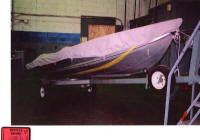
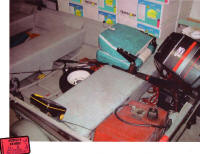
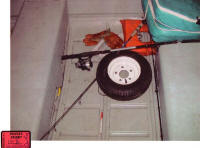
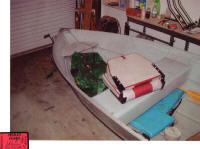
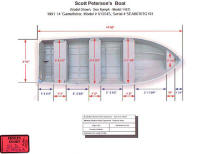
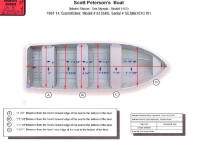
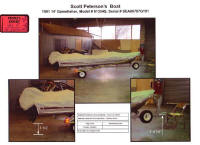
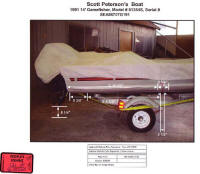
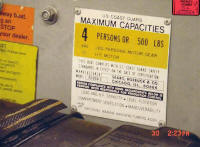
1st Search of the Boat -- December 24, 2002
Scott told the officers and Detective Brocchini that he had been fishing in his own boat at the Berkeley Marina that day. Brocchini asked to see the boat, and Scott told him that it was at the Warehouse. Brocchini, Evers, and Scott went to the Warehouse, and Brocchini looked at the boat and took some pictures. No evidence was seized from the boat that night.
People's 70A-Z show the pictures that Brocchini took of the boat that night, but most of them are only negatives or distorted or inconsequential, so I'm not including them here.
Boat seized and evidence collected
The boat was searched and seized as part of the 1st search warrant executed on December 27, 2002. Detective Dodge Hendee was the Crime Scene Manager. Hendee is the one who found the yellow pliers in the boat.
Before the search began on the 27th, Eloise Anderson brought her cadaver dog, Twist, into the Warehouse as part of the search. She reported Twist's reactions to the MPD in a report dated December 29, 2002, of which a segment was copied into the People's Response to Defense Motion to "Traverse" Wiretap Affidavits, filed October 17, 2003.
Twist-Warehouse: We then moved to the location of the storage area where Scott Peterson has his office/warehouse. After the Modesto D had completed an initial check of the area, I worked the dog. The office was small and the dog showed no interest in this area. The warehouse area was used to store chemicals and Mr. Peterson's fishing boat. Much of this area was inaccessible to the dog and the chemical smell made searching very difficult. The dog worked to the back of the warehouse and into the bathroom twice with no alerts or interest. I put her into the boat where she showed mild interest but no alerts. When I worked her in front of the warehouse area she showed interest in some containers under a small workbench. She checked several times in each container, along the edge of the workbench where she could reach and along the edge of the boat closest to the workbench. She demonstrated frustration by barking, but did not go to her full alert or pinpoint a particular spot. At that point we exited the warehouse.
According to the State's theory, Scott put Laci into the boat at the warehouse, then drove to the Berkeley Marina, a 90 mile drive, launched the boat, motored out towards Brooks Island, dumped her body -- and yet there was no cadaver scent in the boat.
Drawing of placement of evidence placards in boat
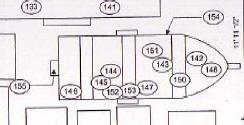
Item 142, water in the boat
Item 143, handmade anchor found in the bottom of the boat
Item 144, pair of yellow-handled pliers found in the bottom of the boat
Item 144a, hair found in the pair of yellow-handled pliers
Item 145, A pair of wet orange work gloves found on the floor of the boat
Item 146, A red rope and metal clasp on the ends
Item 146a, A hair fiber collected from the rope (146)
Item 147, A brown cord shoestring collected from the floor of the boat
Item 148, Green duffle bag
Item 148?, Camouflage jacket
Item 148c, 2 lures & July 23, 1999 2-day fishing license found inside #148
Item 148d, A single Remington 20 gauge, single shot, birdshot round found inside #148
Item 149, A package of 16-gauge, 200 foot wire, it was unopened and found on top of the trailer
Item 150, A fiber taken from the tip of the paddle found inside the boat. The fiber appears to be orange or reddish in color and approximately one quarter to one half inch in length
Item 151, brown tackle box with numerous lures and fishing accessories found in the bottom of the boat
Item 152, A Master Fish 650 GR rod and reel with lure attached
Item 153, A Pro Guide fishing rod and reel. It should be noted that the reel had a busted crank and was inoperable for use
Item 154, A Game Fisher 14-foot aluminum boat with a CF #2313HO located in the warehouse
Item 155, A liquid sample from the boat engine. The liquid sample was only about a tablespoon or so and was dirty in color, probably a combination of water and oil
Item 300, Red Bic pen
Item 301, Right side amber trailer light
Item 301, Liquid sample from #301
Item 302, Water sample from boat motor
Item 303, Fuel sample
Item 304, Hair sample
Item 305, Right rear and left rear tire impressions
Item 306, Four swabs from boat motor water pump
Item 307, Surface samples
Item 308, Carpet sample
Item 309, Carpet sample
Item 310, Fishing reel parts
Item 311, Pine needles
Item 312, Fishing hook
Item 312, Sale tag
Detectives took a sample of the water standing in the boat and also seized two parts of a fishing reel (handle from the crank off the reel), Item 310.
February 5, 2003: The red paint transfer
Detective Grogan testified that investigators theorized Scott would have had to tie the boat to something in order for it not to capsize when he attempted to throw Laci overboard. Grogan sent Detective Owen to see if the boat had any paint transfers. Grogan reported that he "found some red paint on the side of the boat and in some of the threads of the screws on one side where the fishing pole holder was located." Samples were taken, as well as samples of the paint used on Buoy 4, in the area of Brooks Island, where Gene Ralston believed he found Laci's body in mid-March, 2003. Sarah Yoshida did the tests, and she reported that they did not match. Grogan had Hendee research to see if there was a painting schedule such that the Buoy could have been painted since December 24, 2002, but it hadn't been.
Defense 7K, taken by the MPD on February 5, 2003, shows Detective Skultety looking for signs of paint transfer, and Defense 7J shows the red hand truck (dolly) next to the boat, after the boat was impounded. Mark Geragos argued that the paint transfer on the boat came from the red hand truck. Grogan explained that they didn't take a sample of the red hand truck to see if it matched the paint transfer on the boat because the report indicated wood attached to one of the flakes, and the hand truck is all metal.
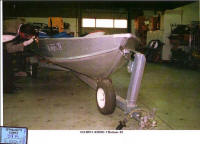
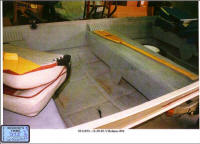
The boat was again examined by Detective Rudy Skultety. Detective Skultety had Mr. Donabedian from Tunney's Marine examine the boat motor, to try to pull start the motor and to take the motor apart and take samples of what was in the tank. Donabedian had difficulty starting the motor and failed after several attempts, "but eventually somebody put their foot on the motor -- not on it but up against it, and it fired right up." Donabedian dismantled the motor and Skultety took a sample of the contents of the gas tank. The motor was then re-assembled.
On this same date, Skultety directed CSO Lovell to collect several items from the boat and booked them as evidence.
Sample from gas tank
One wooden oar
One orange life vest
Two blue seat cushions (not attached to the boat)
Three black rubber bungee cords with a hook on each end
One roll of black electrical tape
A plastic bottle of 2-cycle oil
Debris vacuumed from the bottom of the boat, after all contents had been removed
On Tuesday, July 27, 2004, the Jurors were taken to the garage where the boat was kept and allowed to see it. They were not allowed to touch it or to ask any questions. This viewing immediately preceded the testimony of David Weber.
Boat stability tests and measurements of the boat
David Weber, VP Engineering Lowe Boats, was tasked by the State to prove to the Jury that the boat could handle Scott having used it to dump Laci's body. Weber testified that the boat passed the Coast Guard standard for flotation, stability, and side stability, and had the capacity for 4 people, or 500 lbs., with a maximum capacity of people, motor, and gear to be 680 lbs.
Weber also described, under cross, the three tests that are done, and provided these pictures, Defense 5D.
Kevin Bertallato, investigator for the Stanislaus County DAs office, involved Kim Fulbright, also an employee, to do a demonstration showing that a pregnant woman Laci's size could fit into the boat and not be seen. He had Kim get into each of the 3 sections of the boat. These pictures, People's 106F-K, depict the demonstration. The 3 pictures of Fullbright in the boat were taken at a straight on angle with the boat being on a trailer. As it is, Fullbright is partially seen in the 1st and 2nd photos (click to enlarge for a better view). She would have been even more visible with the boat in the water. The amount of space she occupied in each section would have also made it awkward for someone to manipulate her body into position for pushing overboard.
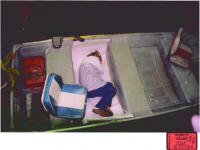
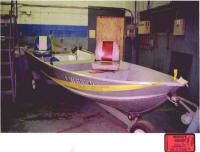
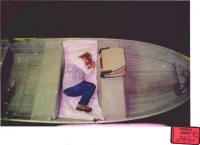
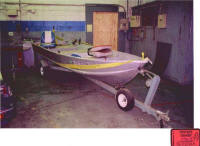
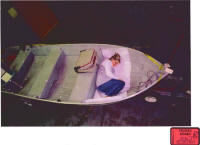
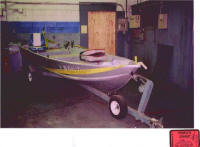
Mark Geragos' boat demonstration and boat display
Mark Geragos purchased a boat similar to Scott's and had his assistant do a demonstration trying to dump a dummy the size of Laci and weighted down with the same number and size of weights the State claimed Scott used. In the demo, he was unsuccessful in throwing the dummy overboard. Judge Delucchi would not admit the demo because he said it could not duplicate the exact conditions.
During jury deliberations, Geragos moved the boat to the parking lot for the building he owned in Redwood City. The parking lot is across the street from the local FoxNews office, and word soon spread that the boat was there. Nancy Grace called Sharon Rocha to inform her. Gloria Allred gave a press conference standing next to the boat. The sum of the PR was very negative for Geragos, as he was accused of putting the boat there in order to influence the jury. However, the boat was not on the route the bus which transported the jurors took, and neither was it in view of the courthouse. The boat was removed the following day. Following are pictures I took of the boat, which was turned into a shrine for Laci and a vicious attack upon Scott.
On Monday, November 8, 2004, during jury deliberations, the 12 Jurors were taken to see the boat. What occurred resulted in a request for a mistrial and may very well be a reversible error.
These are the juror's descriptions after they were released from duty:
John Guanasso, as reported by Garth Stapley, ModBee, on March 12, 2005.
One juror, with the judge's permission, climbed inside and shook the boat, Guinasso said. Geragos later tried to use that incident to ask for a mistrial. But the real buzz among jurors was prompted by Peterson's reaction when the juror sat in the boat, Guinasso said. "(The juror) reached over like he wanted to see if he could toss somebody overboard," Guinasso said, "and Scott Peterson dropped his chin almost to his chest."
Greg Beratlis, as related to Greta Van Susteren, On the Record, December 14, 2004.
VAN SUSTEREN: Who got into the boat?
BERATLIS: Well, you asked me, so I figured you know. It was me.
VAN SUSTEREN: Oh, actually, no. I didn't know that!
BERATLIS: It was me and it was the original foreman.
VAN SUSTEREN: All right. You asked permission from the judge, and he said, Go ahead, right?
BERATLIS: Correct. I made sure.
VAN SUSTEREN: Why did you want to get in the boat?
BERATLIS: Because there were questions about the stability of the boat that when we listened to the experts, I don't think those questions were answered in our minds. We needed to have a little bit more to that. And I climbed in the boat. You know, to look, like everybody was saying, at pictures, didn't mean much to us. And not being able to get in the boat originally for some — we walked out there, we were, like, hands off, and kind of walked around with your hands in our pockets. And we didn't know what we could do. And then when we got to the deliberation, we said, you know, Can we go and look at the boat? Can we physically get inside the boat? And then when the judge agreed to it and he asked, I believe, the rest of the — you know, the defense and the prosecution, and they said OK, we did it, you know? It was a matter of just getting an idea of the boat. Looking at it in a picture didn't speak much.
VAN SUSTEREN: Greg, the description the judge gave in court is that you got in it and you rocked back and forth or I think jumped up and down. How would you describe what was done in that boat?
BERATLIS: We tried rocking it. One of them was standing — one person was standing up, and another person was kneeling. I was the person kneeling. And we were trying to show what was the buoyancy. And then we were also directed that realize the boat was not in the water and that the situation, the reaction would be different. And we took that into account. We understood that. We acknowledged that.
Delucchi gave his reason for allowing the jurors to get into the boat:
I did advise the jury that they should bear in mind that this boat was not in the water as they stood in the boat. And I also advised them that the boat appeared -- also that the boat was secured to a trailer. The reason why the Court permitted the jury to get into the boat initially -- I didn't know they were going to jump up and down on the boat -- was the fact that the District Attorney had presented an experiment where they had -- a representative of the District Attorney's Office had actually laid down flat in the boat. And I thought it was important for the jury to take a look, see if there was enough room for somebody to sit -- lay down flat in the boat. That was not, in my opinion, taking additional evidence because it was already set forth on the record.
What Delucchi failed to admit is that the actions of the two jurors who got into the boat exceeded anything that had been presented during the Trial, and thus constituted taking additional evidence. Beratlis makes it very clear that they wanted more than what had been provided by the testimony. Whether he expected them to or not, they did it, and he should have declared a mistrial on the spot.